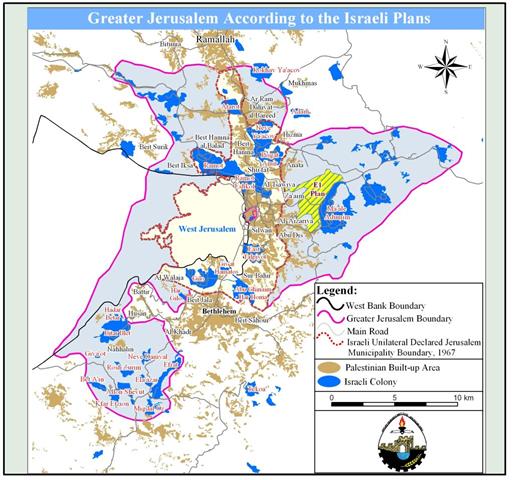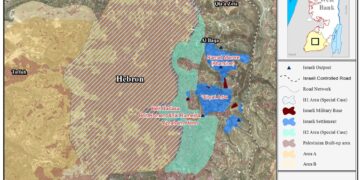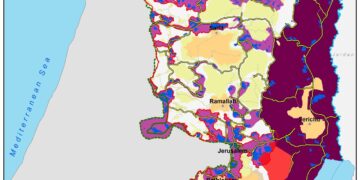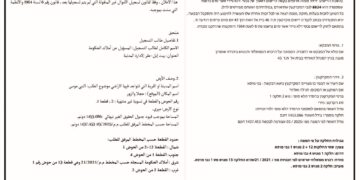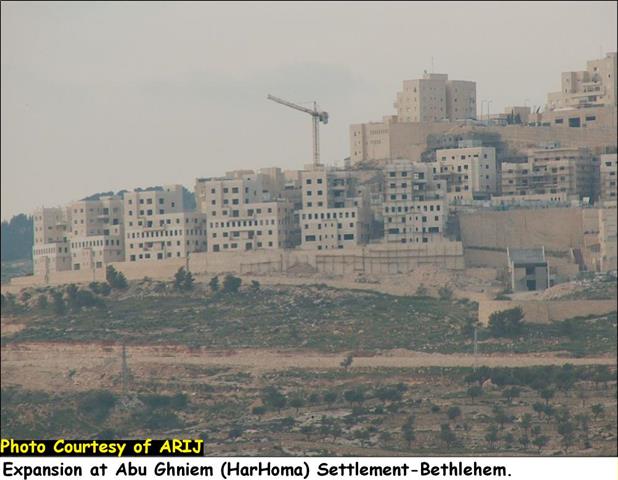The {E1} Plan: Background
The E1 plan; originally conceived by no other than the Israeli labor party late leader Yitzhak Rabin back in 1995 as a precautionary step and erudite ahead step of future fallout regarding Ma'ale Adumim (established 1975); the most controversial Israeli settlement of all. The original set-up for {E1} plan is to take place west of Ma'ale Adumim settlements on 6100 Dunums, which comes from the 22000 Dunums confiscated Palestinian lands (Abu Dis, Eizariya, Isawiya, Anata, Tur and Ez-Z'im) and comprise the 1983 master plan of Ma'ale Adumim settlement bloc (Ma'ale Adumim, Mishor Adumim, Kfar Adumim, and Allon). The {E1} aimed to hamper Palestinian localities from expanding the built-up areas of their towns and villages and increase Jewish presence in the area through the {E1} pending 3500 new housing units, but more importantly to create corporal link between Ma'ale Adumim settlement bloc and Israeli settlements in Jerusalem (Pisgat Ze'ev, Pisgat Omer, Neve Ya'acov, and the French Hill).
Furthermore, the new addition {E1} to Ma'ale Adumim bloc will constitute a physical barrier that will cut off Jerusalem from the West Bank and break the geographical contiguity of the West Bank into two separate entities; one to the north of Jerusalem and the other is to the south.
In May 27, 1999, Israel Defense Minister Moshe Arens spoke of the {E1} plan and declared an additional 6400 Dunums of Palestinian lands annexed to Ma'ale Adumim dominion, bringing the total area set to establish the {E1} plan to 12,500 Dunums. Including {E1} plan, Ma'ale Adumim bloc with Giva't Ze'ev and Gush Etzion, comprised the 'Greater Jerusalem' region in the proposed map by the Israeli PM at that time Iyahud Barak and published in the Israeli newspaper 'Haaretz daily' in May 27th, 1999. See Map 1 and Cross section of Greater Jerusalem Map
What's New with the {E1} Plan?
In June 2004, the Israeli PM Sharon and his Defense Minister Mofaz approved a declaration proclaiming hundreds of Dunums as 'State Lands' in the area designated for {E1} plan, just at the same time the Israeli government past approval on the Gaza disengagement plan, only to confirm sharon's statement that reinforcement of West Bank settlement blocs will parallel the Gaza disengagement plan.
Since then, Israel initiated procedures that include land surveying for the remaining area designated for the {E1} plan as preliminary step before declaring the entire area as 'State Lands'. The Israeli Defense Minister Mofaz has also gave the green light to build the preplanned {E1} 3500 housing units, which caused an upset on the Palestinian side and the international community that described the Israeli decision to be provocative at this point; especially when all efforts are online to pump life into the peace process again. The Palestinian Authority demanded the Quartet and the US in particular to rebuff the Israeli plan for the detrimental sequences for such plan that constitute grave violation of all signed accords which stipulates that neither of the conflicting parties shall take any step that might alter the outcome of future negotiation. See Map 2
Israel's PM Sharon have always articulated his intention to continue with the expansion plans set for the large settlements blocs, which he outspokenly expressed in many occasions that it (the large settlement blocs) will remain within Israeli jurisdiction under any final status negotiations with the Palestinians.
'Everybody has to move, run and grab as many hilltops as they can to enlarge the settlements because everything we take now will stay ours… Everything we don't grab will go to them.' Ariel Sharon, Israeli Foreign Minister, addressing a meeting of militants from the extreme right-wing Tsomet Party, Agence France Presse, November 15, 1998.
{E1} & Greater Jerusalem
When Israel declared the occupied East Jerusalem part of the unified and eternal Capital of the State of Israel, it had done so after realizing it will not be able to combat the demographic parity that favors the Palestinian on the long run, an issue that made Israel recognize the need to inflict new facts on the ground and ensure Jewish majority thus making any negotiation over the city's fate utterly infertile and for that purpose Israel worked to inflate the population of the Israeli settlements on the outskirts of Jerusalem, also known as the 'outer-ring' settlements, which are set to be inside the Greater Jerusalem parameter; Giva't Ze'ev in the North, Ma'ale Adumim in the East and the Gush Etzion bloc in the south. The expansion of Ma'ale Adumim settlement and that unholy quest for 'Greater Jerusalem' comes with abundance of pain and tribulation to the Palestinians Jerusalemites' who stand not only to lose the lands set for future expansion (Abu Dis, Eizariya, Isawiya, Anata, Tur and Ez-Z'im) but also lose all association with the Palestinian community at large. Furthermore, Israel incised the Palestinian occupied territories to ensure more accessibility to settlers by constructing winged bypass roads that interconnect at Ma'ale Adumim settlement but most importantly to restrict Palestinian movement between the northern and southern areas of the West Bank. The bypass roads encircles Jerusalem, the first of which is Road #45 that swaddle Jerusalem from the north-west at Modi'n settlement bloc and continues north of Jerusalem to Ma'ale Adumim settlement bloc and all the way to the border point on the Jordan river to Jordan. Road # 7 encircles the southern Gush Etzion settlement bloc located south of Jerusalem (part of the 'Greater Jerusalem' plan) to continue eastward to join Road # 45 at Ma'ale Adumim settlement bloc. Today and with the new coerced Israeli metamorphosis (the Segregation Wall), Ma'ale Adumim settlement bloc stands with new master plan that include more settlements (Ma'ale Adumim, Kefr Adumim, Mishor Adumim, Allon, Allmon, Qedar, Neve Brat and Mizpe Yedude) at 62,000 Dunums of lands (including the {E1} 12,500 Dunums) expropriated from the Palestinians. See map 2: Map of the Segregation Wall
The over exaggerated land encompassed for Ma'ale Adumim settlement bloc aims to deny Palestinians from expanding the built areas in their towns and villages; but more significantly to eliminate contiguity between West Bank territory; especially that the built up area (including road system and infrastructure) of all settlements are developed on 12,000 Dunums (less than 20%) of total area designated for the settlement bloc.
The {E1} Plan, Settlements Expansion & International Community
Israeli settlement expansion is considered by international law and community to be illegal; the {E1} plan drew highly criticized responses toward Israel's ongoing settlement expansion policy; starting with the Quartet diligence to induce Israel to stop settlement expansion to more indulgent US perspective, however, a concession that expansions undermine the peace process and viable Palestinian future is conceded perception.
The US awkward position on the {E1} plan comes from a statement made by the US president on April 14, 2004 during a press conference with Israel's PM admitting the Israeli settlements in the occupied Palestinian territory as 'realities' that must be taken into consideration in future negotiation.
'In light of new realities on the ground, including already existing major Israeli populations centers, it is unrealistic to expect that the outcome of final status negotiations will be a full and complete return to the armistice lines of 1949, and all previous efforts to negotiate a two-state solution have reached the same conclusion. It is realistic to expect that any final status agreement will only be achieved on the basis of mutually agreed changes that reflect these realities.' US President Bush's letter to Israel Prime Minister; April 14, 2004.
The above quote shows that the US President went even further by breaching his status as an 'honest' mediator when he described Israel retrieve to the 1949 armistice lines 'unrealistic' thus admitting Israel's right to maintain authority over territories occupied during the 1967 war. Nonetheless, the US President George Bush and his Secretary of State Condoleezza Rice has constantly declared their restlessness with settlements expansion but on the other hand has made it abundantly clear that the US will not pressure Israel with regard to the expansion carried out in large settlements blocs, which according to President Bush became incontestable realities, which the Palestinians must take into consideration.
All and all, Israel has shown nothing but apathy for the international law and the international community, resting assured that criticisms or seldom condemnation would not go any further.
'Every time we do something you tell me America will do this and will do that. .. I want to tell you something very clear: Don't worry about American pressure on Israel. We, the Jewish people, control America, and the Americans know it.' Israeli Prime Minister, Ariel Sharon, October 3, 2001, to Shimon Peres, as reported on Kol Yisrael radio.
Perhaps, the above statement may summarize the US roll during the years of the Palestinian – Israeli conflict, including the illegal Israeli settlements issue that may eventually turn to be a 'deal breaker' on the long searched and over negotiated quest for peace.
The envisioned {E1} plan may not see the day of light until mid-2007 according to Israeli officials, however, the fine prints of the plan is complete and on stand-by status for final approval, which falls not far behind; as soon as the construction of the Segregation Wall (commenced the third week of May 2005) is completed as scheduled before the end of 2005.
Prepared by:
The Applied Research Institute – Jerusalem


